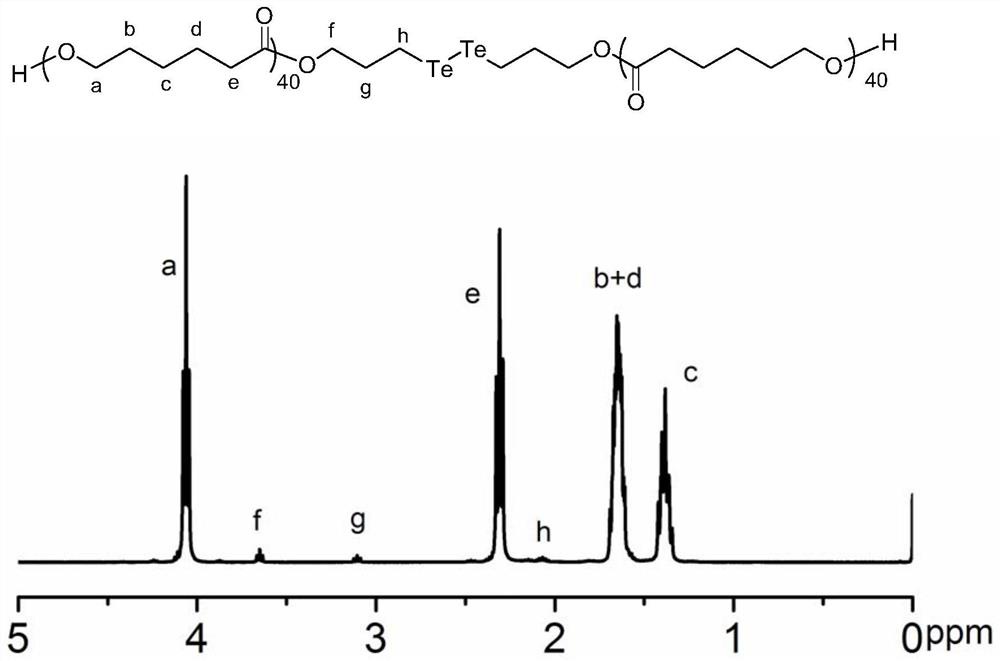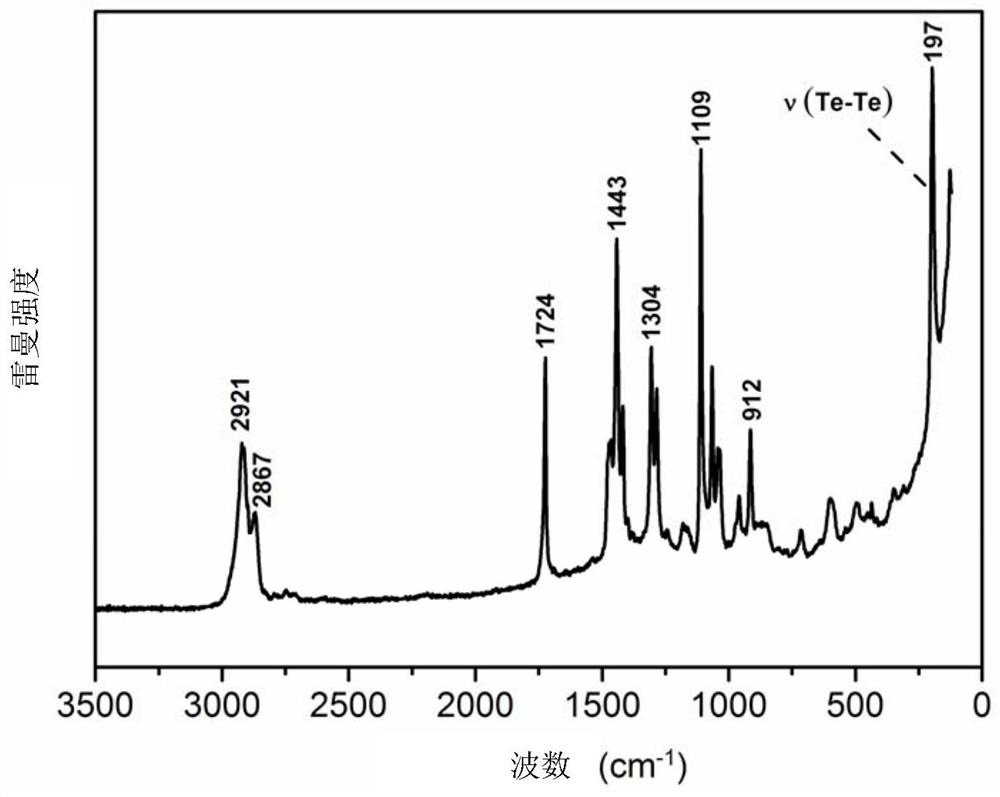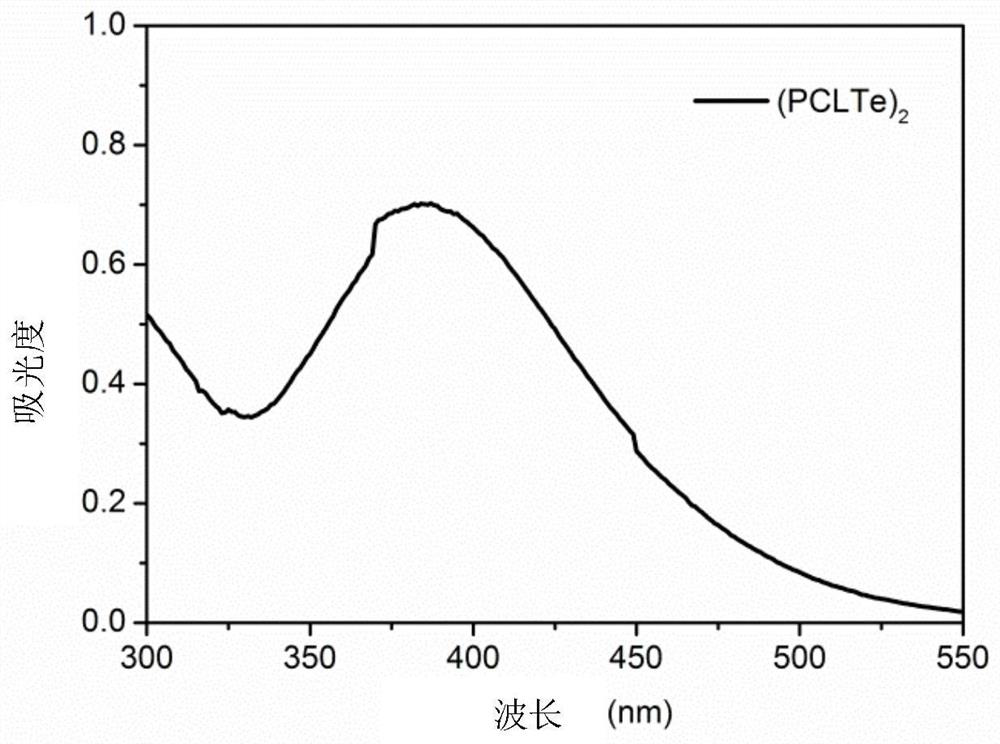A kind of ditellurium-containing biodegradable polymer and preparation method thereof
A technology for degrading polymers and biology, applied in the direction of fermentation, etc., can solve the problems of non-biodegradation, limited application of ditellurium compounds, less ditellurium-containing polymers, etc., and achieves less by-products, excellent light environmental response performance, and yield. high effect
- Summary
- Abstract
- Description
- Claims
- Application Information
AI Technical Summary
Problems solved by technology
Method used
Image
Examples
Embodiment 1
[0031] Embodiment 1 contains ditelluric polycaprolactone (PCLTe) 2 (I-1a)
[0032] Synthesis of 2,2'-Ditelluridedipropanol (II-1)
[0033]
[0034] Weigh (2.2698g, 60mmol) sodium borohydride and deionized water (150mL) into a 500mL reaction bulb and stir until the sodium borohydride is completely dissolved, then add tellurium powder (7.26g, 60mmol) and react at 70°C for 30min, to get the magenta Na 2 Te 2 solution. Then, under nitrogen protection, bromopropanol (8.34 g, 60 mmol) in tetrahydrofuran (150 mL) was added, and reacted at 50° C. in the dark for 5 hours. After the reaction was completed, it was extracted with anaerobic dichloromethane, dried over anhydrous magnesium sulfate, and separated by column chromatography (eluent: dichloromethane: ethyl acetate = 1:2 (v / v)) to obtain a purple-red compound, That is, 2,2'-ditelluridedipropanol (II-1). 1 HNMR (400MHz, CDCl 3 )δ(ppm):3.72(4H,t,HOCH 2 ),3.19(4H,t,TeTeCH 2 ),2.00(4H,m,HOCH 2 CH 2 CH 2 TeTe) and 1.70(2...
Embodiment 2
[0041] Embodiment 2 contains two tellurium polycarbonates (PTMCTe) 2 (I-1b)
[0042]
[0043] Add 2,2'-ditelluridedipropanol (0.372g, 1mmol), trimethylene carbonate (TMC) (4.08g, 40mmol) into a pre-baked eggplant-shaped reaction bottle, and vacuumize at 40°C A small amount of moisture was removed for 3 hours, then Novozymes lipase 435 (0.408 g) and anhydrous oxygen-free toluene (10 mL) were added under nitrogen protection, and the reaction was carried out at 60° C. for 24 hours. After the reaction was completed, the enzyme was removed by filtration, settled in glacial ether, and vacuum-dried to obtain the target product ditellurium-containing polycarbonate (I-1b), with a yield of 91%.
[0044] 1 H NMR (400MHz, CDCl 3 )δ(ppm) (such as Figure 4 shown): a (4.24), b (2.05), c (4.10), e (3.10), d (2.07).
[0045] 125 Te NMR (189MHz, CDCl 3 ) δ (ppm): 388.4.
Embodiment 3
[0046] Embodiment 3 contains ditelluric polycaprolactone (PCLTe) 2 (I-2a)
[0047] Synthesis of 2,2'-Ditelluridediethanol (II-2)
[0048]
[0049] Weigh sodium borohydride (2.2698g, 60mmol) and deionized water (150mL) into a 500mL reaction ball bottle and stir until sodium borohydride is completely dissolved, then add tellurium powder (7.26g, 60mmol) and react at 70°C for 30min , to obtain the purple-red Na 2 Te 2 solution. Then, under nitrogen protection, bromoethanol (7.49 g, 60 mmol) in tetrahydrofuran (150 mL) was added, and reacted at 50° C. in the dark for 6 hours. After the reaction was completed, it was extracted with anaerobic dichloromethane, dried over anhydrous magnesium sulfate, and separated by column chromatography (eluent was dichloromethane:ethyl acetate=1:1 (v / v)) to obtain a purple-red compound, That is, 2,2'-ditelluridediethanol. 1 HNMR (400MHz, CDCl 3 )δ(ppm):3.87(4H,t,HOCH 2 ),3.32 (4H,t,TeTeCH 2 ), and 2.11 (2H,s,HOCH 2 ). 13 C NMR (125MHz,...
PUM
 Login to View More
Login to View More Abstract
Description
Claims
Application Information
 Login to View More
Login to View More - R&D Engineer
- R&D Manager
- IP Professional
- Industry Leading Data Capabilities
- Powerful AI technology
- Patent DNA Extraction
Browse by: Latest US Patents, China's latest patents, Technical Efficacy Thesaurus, Application Domain, Technology Topic, Popular Technical Reports.
© 2024 PatSnap. All rights reserved.Legal|Privacy policy|Modern Slavery Act Transparency Statement|Sitemap|About US| Contact US: help@patsnap.com










